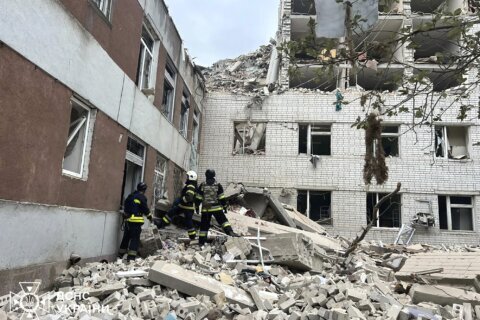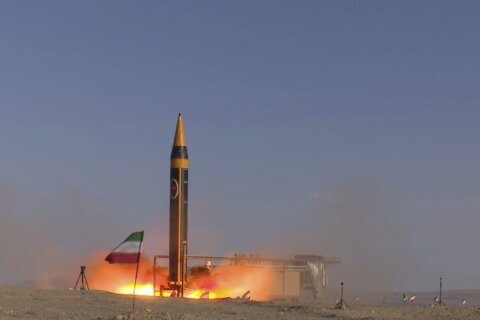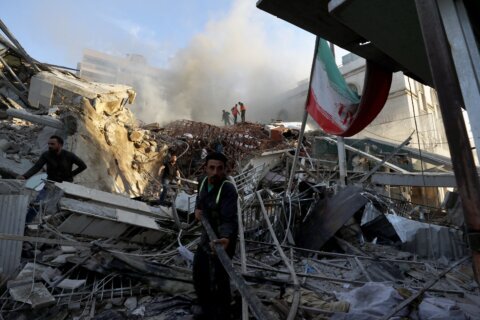WASHINGTON — Last week was a good week for the U.S. coalition fighting militants of the Islamic State of Iraq and the Levant (ISIL/ISIS), as they took back three key locations across Iraq and Syria after two years of tenacious fighting. But ominous signs have emerged indicating that Mosul, Iraq, and Raqqa, Syria, could be the scenes of the most intense, brutal battles in recent times.
“Some of the most difficult fighting lies ahead,” Department of Defense spokesman Navy Capt. Jeff Davis told WTOP.
“In Mosul, they’re digging in. We’re seeing signs that they’re building trenches and berms. They’re creating big pits full of oil and tires to be able to create obscuration fires. They’re digging in with IEDs (improvised explosive devices) and they’re holding civilians there against their will,” Davis said.
The U.S.-led coalition and its 66 other members have systematically limited ISIL’s flow of fighters, supplies and funds, hoping for a showdown with the world’s richest and most brutal terror organization.
Col. Christopher Garver, a former spokesman for Operation Inherent Resolve, said in an interview, “we have been attacking their ability to generate revenue, their ability to store it, to distribute it and use it to pay for the services that they’re trying to provide inside the so-called caliphate.”
Garver added, “We estimated ISIL was bringing in — in its heyday, 2014 — approximately $30 million a month stealing oil, natural gas and selling it on the black market; and we believe we have degraded that to more than half.”
He said military operations, as well, have destroyed more than $500 million the terror group had in storage. That, he said, has limited ISIL’s ability to fund terror operations inside Iraq and Syria. It has also put a strain on ISIL fighters.
“What we have seen is they’ve reduced the salaries of their foreign fighters who were promised a certain amount of money and then they come in, and their salaries keep getting cut. We also see them raising taxes inside the caliphate to try to fund operations,” Garver said.
There are other signs ISIL fighters are under stress. When Sinjar, Iraq, was liberated in 2015, fighters were found to be heavily reliant on potent, mind-altering drugs, said Bayan Sami Abdul Rahman, the Kurdish Regional Government Representative to the U.S.
“We discovered very, very long and intricate tunnels were ISIS had planned to use as escape routes and also to plant explosives,” Rahman said. In those tunnels, she said, “were places where ISIS fighters had slept because there were blankets, lamps and a lot of drugs.”
One of the drugs U.S. and coalition forces found is Captagon, an amphetamine that stimulates the central nervous system, boosts confidence and increases alertness and physical performance.
“Clearly, some of the ISIS fighters need to take these drugs that make them high, perhaps give them a sense of fearlessness, or just to take them out of the situation so that they’re able go on these suicidal missions so, or undertake these terrible cruel acts,” Rahman said.
She believes the drugs were provided for the fighters to face their true reality as a part of ISIL.
“Many of the foreign fighters are really cannon fodder. And these drugs to encourage them to give them the courage that they truly lack to be able to conduct these terrible missions,” Rahman said.
The progressive squeezing of the self-styled government by the coalition, according to Garver, “is also resulting in disgruntled citizenry inside the ‘caliphate.'”
ISIL’s foreign fighter flow is shriveling due to the systematic sealing, by the coalition, of trafficking routes for humans and supplies. In fact, the fall of Manbij, Syria, from ISIL control may be a blow the group can’t recover from.
“We have closed the Manbij pocket area that abuts the border with Turkey where foreign fighters can flow in and where terrorists can leave,” Davis said.
The constant campaign over the past two years to degrade ISIL’s transit routes according to Garver, “has really had a significant impact on their fighting force. They’re down from 2,000 foreign fighters flowing in each month to about 200 to 500 a month.”
Many have deserted the ISIL fighting force. Davis suggested that ISIL’s crumbling infrastructure and defeats will accelerate. “They are a weakened enemy and we are seeing them get weaker, and that these victories are coming more quickly and in greater proximity to each other,” Davis said.
In addition to a defeat in Jarablus, Syria, near the Turkish border on Aug. 24, the group suffered significant defeats in Qayyara and Khalidiya in Iraq two days later.
“Across the entirety of Iraq and Syria, we are seeing a weakened ISIL. And at the same time we are seeing their attempts to counter-strike being beaten back,” said Davis.
The U.S. coalition senses ISIL is desperate and the digging in Davis referred to in Mosul is widely expected to complicate efforts to re-take it and Raqqa, ISIL’s other pseudo capital in Syria. Air strikes will be relied upon heavily.
“We are the nation that conducts the most effective and precise air strikes ever in the history of the world, in terms of what we’re able to do to ensure that we are not hitting. We will work with our partners on the ground to make sure this happens,” Davis said.
“This is gonna be a tough thing; we know that,” he said.








